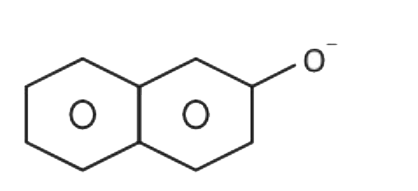Resonance structures can be written for .
O3
NH3
CH4
H2O
The correct Answer is:A
To determine which molecules can exhibit resonance structures, we need to analyze the bonding and electron arrangements in each molecule. Resonance structures are typically possible when there are double or triple bonds that can shift between different atoms.
1. Identify the Molecules: The question asks for resonance structures for specific molecules. Let's consider the following:
- Ozone (O₃)
- Ammonia (NH₃)
- Methane (CH₄)
- Hydroperoxyl (HO₂)
2. Analyze Ozone (O₃):
- Ozone consists of three oxygen atoms. Each oxygen has six valence electrons.
- The Lewis structure shows a double bond between one pair of oxygen atoms and a single bond with a coordinate bond involving the third oxygen.
- Resonance Structures: The double bond can shift between the two oxygen atoms, creating different resonance structures. Thus, ozone can exhibit resonance.
3. Analyze Ammonia (NH₃):
- Ammonia has three hydrogen atoms bonded to a nitrogen atom with a lone pair on nitrogen.
- The bonding consists of single sigma bonds only, with no double or triple bonds present.
- Resonance Structures: Since there are no double bonds, ammonia cannot exhibit resonance.
4. Analyze Methane (CH₄):
- Methane has four hydrogen atoms bonded to a carbon atom, forming four single sigma bonds.
- There are no lone pairs or multiple bonds.
- Resonance Structures: Methane cannot exhibit resonance due to the absence of double or triple bonds.
5. Analyze Hydroperoxyl (HO₂):
- Hydroperoxyl consists of an oxygen-oxygen single bond with hydroxyl (OH) groups.
- There are two lone pairs on one of the oxygen atoms, but there are no double or triple bonds.
- Resonance Structures: Hydroperoxyl cannot exhibit resonance due to the absence of double bonds.
Conclusion:
Among the given molecules, only ozone (O₃) can exhibit resonance structures due to the presence of double bonds that can shift between the oxygen atoms. The other molecules (NH₃, CH₄, and HO₂) do not have the necessary bonding arrangements to allow for resonance.
- Ozone (O₃)
- Ammonia (NH₃)
- Methane (CH₄)
- Hydroperoxyl (HO₂)
- Ozone consists of three oxygen atoms. Each oxygen has six valence electrons.
- The Lewis structure shows a double bond between one pair of oxygen atoms and a single bond with a coordinate bond involving the third oxygen.
- Resonance Structures: The double bond can shift between the two oxygen atoms, creating different resonance structures. Thus, ozone can exhibit resonance.
- Ammonia has three hydrogen atoms bonded to a nitrogen atom with a lone pair on nitrogen.
- The bonding consists of single sigma bonds only, with no double or triple bonds present.
- Resonance Structures: Since there are no double bonds, ammonia cannot exhibit resonance.
- Methane has four hydrogen atoms bonded to a carbon atom, forming four single sigma bonds.
- There are no lone pairs or multiple bonds.
- Resonance Structures: Methane cannot exhibit resonance due to the absence of double or triple bonds.
- Hydroperoxyl consists of an oxygen-oxygen single bond with hydroxyl (OH) groups.
- There are two lone pairs on one of the oxygen atoms, but there are no double or triple bonds.
- Resonance Structures: Hydroperoxyl cannot exhibit resonance due to the absence of double bonds.
Among the given molecules, only ozone (O₃) can exhibit resonance structures due to the presence of double bonds that can shift between the oxygen atoms. The other molecules (NH₃, CH₄, and HO₂) do not have the necessary bonding arrangements to allow for resonance.
Topper's Solved these Questions
- CHEMICAL BONDING (BASIC)BOOK - VK JAISWAL ENGLISHCHAPTER - CHEMICAL BONDING (BASIC)EXERCISE - Level 2
62 Videos
- CHEMICAL BONDING (BASIC)BOOK - VK JAISWAL ENGLISHCHAPTER - CHEMICAL BONDING (BASIC)EXERCISE - Level 3 (Passive 1)
6 Videos
- CHEMICAL BONDING (ADVANCED)BOOK - VK JAISWAL ENGLISHCHAPTER - CHEMICAL BONDING (ADVANCED)EXERCISE - SUBJECTIVE PROBLEMS
64 Videos
- CO-ORDINATION COMPOUNDSBOOK - VK JAISWAL ENGLISHCHAPTER - CO-ORDINATION COMPOUNDSEXERCISE - LEVEL 2
144 Videos
Similar Questions
Knowledge Check
Which of the following is not a resonance structure of the other?
ACH3−N=C=SandCH3−S−C≡NBCH3−+C=OandCH3−C≡+OCCH3−O∣∣C−OHandCH3−O−∣C=+O−HDCH2=CH−C≡Nand+CH2−CH=C=N−
How many resonance structures are possible for allyl carbocation?
View SolutionIdentify the correct resonance structures of carbon dioxide from the one given below:
View SolutionIdentify the correct resonance structures of carbon dioxide from the one given below:
View SolutionHow many resonating structures are possible for the following structure (including the given structure)?

View SolutionWrite the resonance structures of the given compound.

View SolutionWhich of the following is not a resonance structure of the other?
View SolutionExplain the resonance structure of benzene. What do you understand by resonance hybrid?
View Solution
